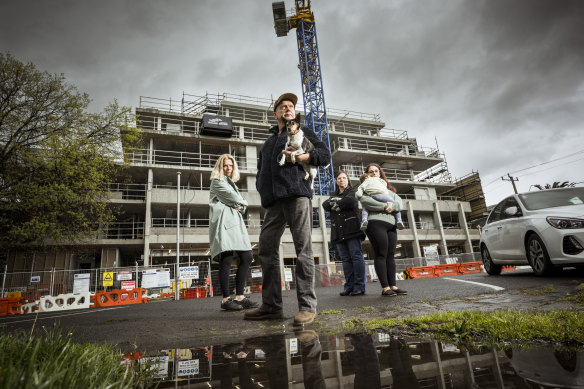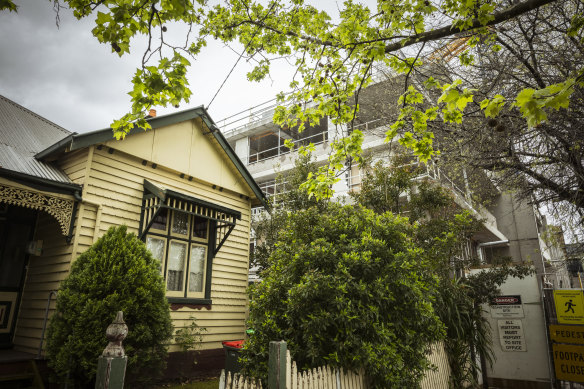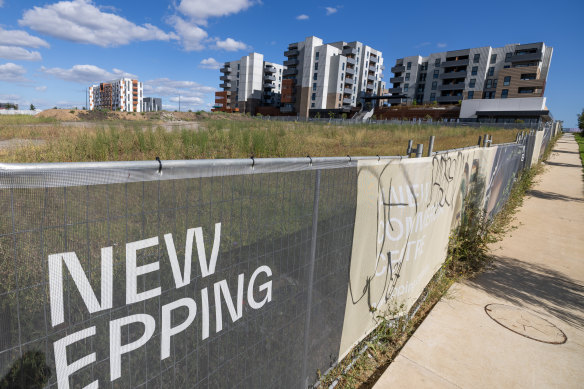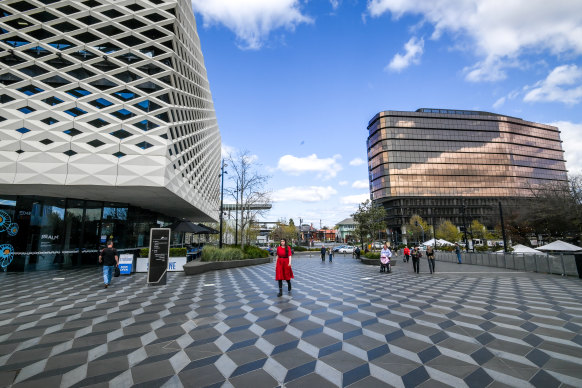By Adam Carey and Sophie Aubrey
Preston, Ringwood, Epping and Camberwell have been targeted for the biggest increases in new apartments as the state government races to seize planning controls in 10 established suburbs and build 60,000 new units.
Figures published by the Victorian Planning Authority reveal which suburbs will do the heavy lifting and how many extra homes are proposed for each of the 10 urban “activity centres” Labor has named in its housing pilot program. The ambitious program seeks to sideline potential objectors in the planning process and trigger an apartment boom across middle Melbourne.

Essendon residents Anne Ferris, Peter Riley, Theodora Vasiliadis and Michelle Palmieri are concerned housing construction will see their streetscapes altered.Credit: Chris Hopkins
The planning takeover will clear the way for developments of between 10 and 20 storeys in the core of these suburban activity centres, and for developments of between three and six storeys in the mostly low-rise “walkable catchments” surrounding them.
Local politicians and residents have blasted the government for rushing plans through with minimal consultation or detail on how their low-density suburban infrastructure will support thousands of new homes.
The government wants to introduce its new planning controls before the end of the year. It has framed them as a way to encourage developers to build more homes in suburbs that are close to public transport, shopping centres and jobs.
Councils and residents will have fewer avenues to object to housing proposals that are “deemed to comply” with the state government’s new urban design principles. The planning overhaul includes revoking councils’ power to refuse a development due to a building’s height or setbacks within each activity centre, as long as the development satisfies state guidelines.
Preston, in Melbourne’s middle-north, has the highest target range of all 10 centres in the pilot program, with between 11,800 and 15,300 new homes envisaged to be built there. The program proposes a development core along the commercial spine of High Street, but also fanning out into more than 100 quieter streets in Preston and neighbouring Reservoir.
Outer-northern Epping (9800 to 13,900 new homes), eastern suburb Ringwood (8200 to 12,200 new homes) and Camberwell in the inner east (7500 to 10,100 new homes) are also targeted for the heaviest increases in housing between now and 2051.
Between 6500 and 8000 homes will be built in Chadstone, where the most intensive development will occur at the shopping centre, which is Australia’s largest mall but has neither train nor tram connections, relying solely on buses for public transport. Development would most likely occur on land currently used for car parking.
In Melbourne’s north-west, Niddrie and Essendon North will together get an extra 8500 to 10,200 new homes, with development concentrated along busy Mount Alexander and Keilor roads, but also extending into low-rise neighbourhoods in Airport West and Strathmore.
Frankston (4000 to 6300 homes) and Broadmeadows (3000 to 4500 homes) have the lowest targets of the 10 activity centres. In Broadmeadows’ case, this is partly because building heights must be limited to 12 storeys due to flight controls for Essendon Airport.
Susanne Newton, a Greens-aligned council candidate and incumbent mayor for Darebin City Council, attended the two community reference group meetings the government held for the Preston activity centre this month.
Newton said there was disquiet about a low amount of consultation, given the state is proposing to add thousands of new apartments to the suburb.

A multi-storey development going up in Essendon.Credit: Chris Hopkins
“I would say the process is very rushed, and the community is suss on that; it’s also happening over a [council] election period, so the council can’t be involved.”
Newton queried whether the government had developed plans to deal with the extra traffic, or increased demand for schools, childcare and open space.
The consultation period unfolded during the council election caretaker period, which began on September 17, effectively silencing councils that have been vocal on state ambitions to seize planning powers.
Moonee Valley council candidate and incumbent mayor Pierce Tyson said municipal planners had just six days to prepare a submission in response to the plans for Niddrie and Essendon North before the council entered caretaker mode.
“Right now, we can’t fully utilise council resources to make it clear our opposition to this plan.”
The council’s submission is scathing of insufficient detail and a “lack of procedural fairness” in the development of and consultation over the proposed changes. Tyson, who is Labor-endorsed, said the state’s plans were being rushed through without thought to local context.
“We’re having our democratic right to object and shape these plans removed through this process,” he said. “What most residents are concerned about are the catchment areas of these plans, which spill into suburban streets, and I think could reshape and destroy what makes our areas great.”
Essendon locals Peter Riley and Anne Ferris both learnt of the government’s plans for their area when they received a Victorian Planning Authority flyer in their letterboxes a few weeks ago.

Development of the former Epping quarry site is starting to take shape, with 151 social housing apartments and a private hospital recently opening.Credit: Jason South
The neighbours said people living in the catchment area were just beginning to learn how their streets could be transformed, with housing blocks between three and six storeys built next door to them in what is mostly a low-rise area.
Both said the area was already straining to serve residents’ needs. Ferris said schools and childcare were at capacity, and it took days to get a booking at the local medical centre.
“The roads are absolutely clogged. You can’t drive a nail down these roads at the best of times,” Riley said.
There is no train station inside the Essendon North and Niddrie activity centres, which has the route 59 tram running through its spine.
Riley said that if the government was determined to ramp up housing in his area, “it’s important that they don’t destroy the liveability of the neighbourhood – not just for the people here now, but for the people they are planning to build for”.
Coalition planning spokesman James Newbury said the Labor government had an extreme plan “to rip away the rights of 10 communities from having a say over the future of their streets”.
“What’s worse is their anti-established-suburb agenda encourages up to six-storey developments in your quiet suburban street and ignores existing heritage protections,” he said.
The activity centres plans do not propose to remove heritage overlays.
Monique Ryan, Camberwell’s federal MP for Kooyong, wrote to state government ministers on September 23 to formally request an extension to the four-week consultation period, which closed on Sunday. She did not receive a response.
Ryan said she supported an increase in housing but was appalled that the state was hurrying through plans to jam thousands more homes into Camberwell without presenting an impact assessment on drainage, transport, schools and amenity.
“How can you expect that people aren’t going to be threatened by this, or anxious? The little information we know suggests there could be a really significant negative impact,” Ryan said.
The Victorian Planning Authority argued in a draft summary report for the activity centre program that uncertainty among developers about whether housing projects will be approved has stopped Melbourne’s suburban activity centres developing to their full potential.
“Activity centres present a key opportunity to contribute to housing growth in established urban areas, particularly in the form of compact housing such as apartment and multi-dwelling developments,” the authority said.

Ringwood Square stands in the core of an activity centre that is being targeted for more than 10,000 new homes.Credit: Justin McManus
“The inconsistent nature of planning provisions currently applied across Melbourne’s activity centres, along with uncertainty in approvals processes are identified as contributing factors limiting the ability to deliver more housing in these centres.”
The Planning Authority said new conditions would be included to prevent “under-development” in activity centres, such as blocking any building that is less than 50 per cent as high as the proposed maximum.
A Victorian government spokesman said the status quo was not an option.
“We need to deliver more housing choice where Victorians are telling us they want it – close to public transport, jobs and services and close to where they grew up,” he said.
“The proposed settings for the activity centres will give community and industry certainty over what can be built and where, while protecting the things that matter – sunny streets, parks and good design.”
Dr Stephen Glackin, a senior research fellow at Swinburne University’s Centre for Urban Transitions, endorsed the state government’s planning takeover in the 10 activity centres.
Glackin has previously developed a proposal for Maroondah City Council on merging individual housing lots to build larger, higher-density projects – another proposal put forward in the draft planning overhaul.
“I understand subsidiarity and the principle that everything should come from the bottom up, but when you are thinking about 5 million people, you need some serious consideration from the top down,” Glackin said.
He said neighbourhood character was no grounds for stopping greater housing density.
“We need to look to future character and start to design not for what is there now, but what’s going to happen anyway through the slow erosion of built form. We’re going to end up with those sorts of densities anyway, so why not look to the future and do it properly?” he said.
The Morning Edition newsletter is our guide to the day’s most important and interesting stories, analysis and insights. Sign up here.